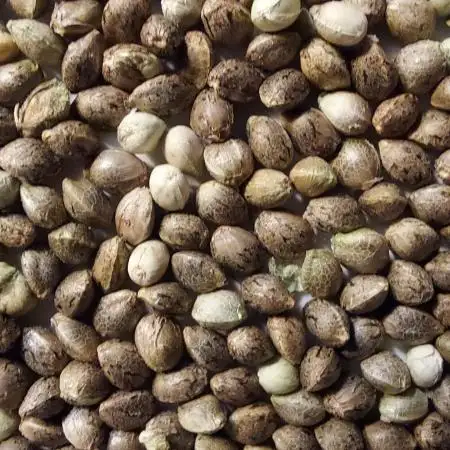The Grow Awards 2026 🏆
Lampenabstand
BruceCannastarted grow question 2y ago
Abstand der Lampe? Sanlight Q4W; 150W.
1. Woche. Im Moment 70 cm?!
Solved
Week 1 likes
LuckyBeardLukeanswered grow question 2y ago
Ja, das ist für das Stadium absolut ausreichend. Deine Pflanzen sehen auch absolut i.O. aus - sonst hätten diese Geilwuchs und sähen viel spargeliger aus, wenn das Licht zu gering wäre. Zu nah an den Pflanzen und dadurch zuviel Licht kann durchaus schnell schiefgehen. Cannabis-Setzlinge haben nur einen geringen Lichtbedarf. Ihr neues Blattgewebe wird durch übermäßiges Licht oder Hitze leicht beschädigt. Später, wenn die Pfanzen kräftiger sind (Würde sagen, 3-5 nodes mit "richtigen" Blättern, kannst du den Abstand auf 40 verringern, dann können die auch mehr Licht ab)
00110001001001111Oanswered grow question 2y ago
Check wiki for "Daily Light Integral" -- getting the gist of this can help guesstimate power and hours of operation for optimal DLI (35-40DLI with ambient atmospheric CO2 is as high as you want to go... supplement CO2 and you can go higher). Other caveat -- this 40 DLI suggestion is based on what the light produces at the diode, so what hits the canopy will be a bit less (absorbed by walls or physically missing the leaves). that's build into common hanging distances and expectation of reflective walls..
it is a loose estimate that will need to some observation and adjustment from you.
400umol/s is produced by that light... dividing that by area in meters-squared gives you PPFD -- this assumes common sense things like the light being hung at a distance that properly covers the growing area wall to wall. this would be more useful for a fullly grown out garden..
Referencing this PPFD calculation with hours of operation on a DLI chart will give you a quick guesstimate of DLI provided. Shoot for 40 for mature plants, and less with seedlings. Maybe 25DLI to start -- but again, observe and react.. take notes about hanging distance and power applied. The resulting internode length (stem between growth nodes) is your guide to light intensity -- not too much stretch but also not too tight.
in context of tiny plants you can absolutely save money early on by reducing power and focusing the light on a smaller area (i.e. closer hanging distnace)
Most lights are made so that the dimmer percentage relates proportionally to umol/s produced. There are some very slight deviations due to efficacy of the driver at different loads and the diodes too, but small and insignificant most times.
as an example : let's say you lower light to focus on 30cm x 30cm. This is .09m^2.
I'll assume 18 hours of operation and work backward from DLI table. About 400 PPFD is the goal for 25 DLI in .09m^2 over 18 hours. 400 * .09 = 36 umol/s focusd on a .09m^2 area is 400PPFD.
10% power from a close distance would probably be fine for seedlings. with your pots, tha area might be a bit larger than 30x30? but this is just an excercise to show you can start with a solid guesstimate that will only need small adjustments as you observe how the plant grows. it is not exact.. there are variables that differ in each garden that will impact just how much light your plant can receive per day compared to another garden.
in my experience, seedlings need a fairly fast ramp up of light that first 5-7 days. just don't let it stretch and don't let it be too tight.
some concepts aboaut hanging distance - inverse square law applies as to how light spreads out the further it is from the source -- i.e. VERY fast. So, more intense light from further away will result in stronger light deeper into the canopy. Early on it is a great idea to get as close as you can and save watts = saves money. However, with fully grown plants wtih a 18-24" deep canopy, you can probably guess that more power and a bit further away can definitely be better. I don't suggest significantly overpowering and hanging far away.. just don't be single-minded focus on beign as close as possible to save watts later on with larger plants.
with that sort of light at full power i'd wager 18-24" will give you good coverage. A free lux meter app can help even out the intensity of light across the canopy -- minimize proportional difference from center to edges -- but don't sacrifice overall average.
autoflowers -- 600PPFD is about as high as you can go for 18hours of operations (38.9 DLI)
Photoperiods in flower phase on 12/12 cycle -- 900PPFD is a good starting goal (38.9 DLI)
you can see that this is inversely 1:1 proportional with hours of operation. 39DLI is the same production/growth rate at any reasonable range of hours of operation.
again, this is a starting point from which you observe and react... based on how your plant reacats, adjust andn take notes of what has the best visible results -- that is where you start in the future and you never have to do this math again, LOL. Probably still need fine adjustments from time-to-time.
1 like
Complain
Krisisanswered grow question 2y ago
They seem to look alright at the moment, but if you do move it, 50.8 cm would be fine. I would watch them an adjust based on how they respond. If they stretch too much then you know it’s too far away and if they seem to not be growing enough, move it closer. Good luck
1 like
Complain
Grey_Wolfanswered grow question 2y ago
your gonna want to lower it by atleast half or the young seedlings will get very leggy and weak
1 like
Complain





